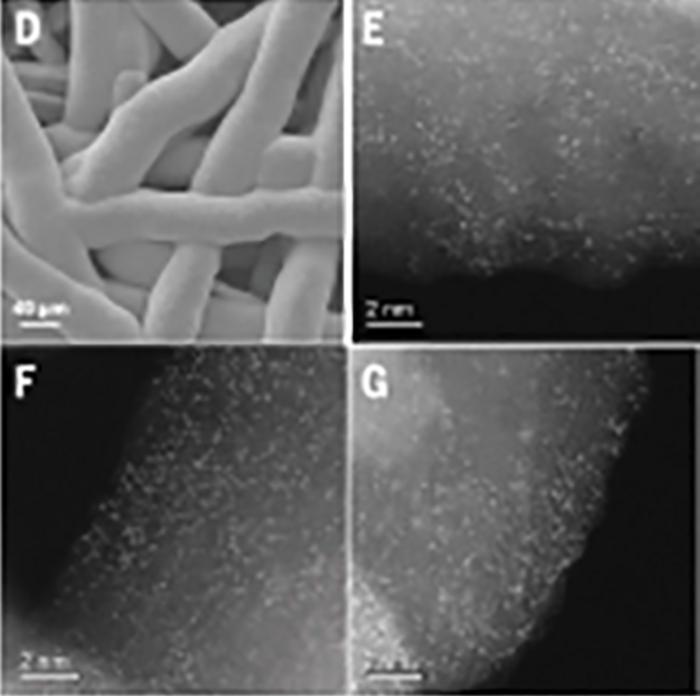Researchers at the RIKEN Center for Sustainable Resource Science (CSRS) in Japan, under the direction of Ryuhei Nakamura, have proposed a novel technique that reduces the amount of iridium required for hydrogen production by 95 %.

Scanning electron microscope image of the synthesized iridium oxide (D) and scanning transmission electron microscope images of the iridium (bright spots) dispersed on manganese oxide electrodeposited on a corrosion-resistant platinum-coated titanium mesh (E,F,G). Image Credit: RIKEN
As the global shift away from fossil fuels gains momentum, hydrogen is emerging as a frontrunner to lead the charge toward a sustainable energy future. However, the widespread adoption of "green" hydrogen, produced without reliance on fossil fuels, has been hindered by the scarcity of iridium, a crucial metal in the process.
In a groundbreaking study, researchers have unveiled a novel approach that slashes the required iridium amount by 95 %, all while maintaining the hydrogen production rate. This breakthrough has the potential to transform our capacity for environmentally friendly hydrogen production, paving the way for a carbon-neutral hydrogen economy.
With 70% of the Earth's surface covered in water, hydrogen stands out as a promising renewable energy source. Yet, extracting hydrogen from water at a scale capable of competing with fossil fuel-based energy production remains a challenge. Current global energy production nears 18 terawatts, signifying that approximately 18 trillion watts of power are generated worldwide at any given moment on average. For alternative green energy methods to supplant fossil fuels, they must match these energy production rates.
The environmentally friendly method of extracting hydrogen from water involves an electrochemical reaction that relies on a catalyst. The most effective catalysts for this reaction, yielding the highest rate and most stable hydrogen production, are rare metals, with iridium reigning supreme. However, the scarcity of iridium presents a significant hurdle.
Iridium is so rare that that scaling up global hydrogen production to the terawatt scale is estimated to require 40 years’ worth of iridium.
Shuang Kong, Study Co-First Author, RIKEN
The Biofunctional Catalyst Research Team at RIKEN CSRS is actively working to circumvent the iridium bottleneck and explore alternative methods for high-rate, long-term hydrogen production. Their ultimate goal is to pioneer new catalysts based on abundant earth metals, ensuring sustainability in the long term. Recently, the team achieved a milestone by stabilizing green hydrogen production at a relatively high level using a form of manganese oxide as a catalyst.
However, transitioning this success to industrial-scale production remains a goal for the future, requiring further research and development.
We need a way to bridge the gap between rare metal- and common metal-based electrolyzers, so that we can make a gradual transition over many years to completely sustainable green hydrogen.
Ryuhei Nakamura, Research Head, RIKEN
The latest study achieves this by blending manganese with iridium. Researchers discovered that by dispersing individual iridium atoms across a sheet of manganese oxide, preventing them from clustering, hydrogen production in a proton exchange membrane (PEM) electrolyzer remained consistent at the same rate as with iridium alone, yet with a remarkable 95 % reduction in iridium usage.
Utilizing this innovative catalyst, uninterrupted hydrogen production was sustained for over 3000 hours (equivalent to about four months) at an impressive 82 % efficiency without any degradation.
The unexpected interaction between manganese oxide and iridium was key to our success. This is because the iridium resulting from this interaction was in the rare and highly active +6 oxidation state.
Ailong Li, Study Co-Author, RIKEN
According to Nakamura, there is a great chance that the amount of hydrogen produced by the new catalyst will be immediately useful.
Nakamura said, “We expect our catalyst to be easily transferred to real-world applications,” he says, “which will immediately increase the capacity of current PEM electrolyzers.”
The group has started working with industry partners who have already made improvements to the first iridium-manganese catalyst. To further reduce the amount of iridium required, the RIKEN CSRS researchers intend to carry out more research on the precise chemical interaction between iridium and manganese oxide. Simultaneously, they intend to carry out testing and deployment of the new catalyst on an industrial scale in the near future, and they will keep working with industrial partners.
Journal Reference:
Li, A., et al. (2024) Atomically dispersed hexavalent iridium oxide from MnO2 reduction for oxygen evolution catalysis. Science. doi.org/10.1126/science.adg5193.